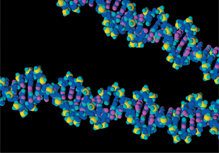As you study biology, you may make different types of inferences. For example, you may generalize about all cases based on information about some cases: All the plant roots I've observed grow downward, so I infer that all roots grow downward. You may determine that one factor or event was caused by another factor or event: The bacteria died after I applied bleach, so I infer that bleach kills bacteria. Predictions may be another type of inference.
Predicting
People often make predictions, but their statements about the future could be either guesses or inferences. In science, a prediction is an inference about a future event based on evidence, experience, or knowledge. For example, you can say, On the first day of next month, it will be sunny. If your statement is based on evidence of weather patterns in the area, then the prediction is scientific. If the statement was made without considering any evidence, it's just a guess.
Predictions play a major role in science because they provide a way to test ideas. If scientists understand an event or the properties of a particular object, they should be able to make accurate predictions about that event or object. Some predictions can be tested simply by making observations. At other times, carefully designed experiments are needed.
Classifying
If you have ever heard people debate whether a tomato is a fruit or a vegetable, you've heard an argument about classification. Classifying is the process of grouping items that are alike according to some organizing idea or system. Classifying occurs in every branch of science, but it is especially important in biology because living things are so numerous and diverse.
You may have the chance to practice classifying in different ways. Sometimes you will place objects into groups using an established system. At other times, you may create a system of your own by examining a variety of objects and identifying their properties.
Classification can have different purposes. Sometimes it's done just to keep things organized, to make lab supplies easy to find, for example. More often, though, classification helps scientists understand living things better and discover relationships among them. For example, one way biologists determine how groups of vertebrates are related is to compare their bones. Biologists classify certain animal parts as bone or muscle and then investigate how they work together.
Using Models
Some cities refuse to approve any new buildings that could cast shadows on a popular park. As architects plan buildings in such locations, they use models that can show where a proposed building's shadow will fall at any time of day in any season of the year. A model is a mental or physical representation of an object, process, or event. In science, models are usually made to help people understand natural objects and processes.
Models can be varied. Mental models, such as mathematical equations, can represent some kinds of ideas or processes. For example, the equation for the surface area of a sphere can model the surface of Earth, enabling scientists to determine its size. Physical models can be made of a huge variety of materials; they can be two dimensional (flat) or three dimensional (having depth). In biology, a drawing of a molecule or a cell is a typical two-dimensional model. Common three-dimensional models include a representation of a DNA molecule and a plastic skeleton of an animal.
Physical models can also be made “to scale,” which means they are in proportion to the actual object. Something very large, such as an area of land being studied, can be shown at 1/100 of its actual size. A tiny organism can be shown at 100 times its size.

Table of Contents
- Formulas and Equations
- Applying Formulas and Equations
- Mean, Median, and Mode
- Estimation
- Using Measurements in Calculations
- Effects of Measurement Errors
- Accuracy
- Precision
- Comparing Accuracy and Precision
- Significant Figures
- Calculating With Significant Figures
- Scientific Notation
- Calculating With Scientific Notation
- Dimensional Analysis
- Applying Dimensional Analysis




